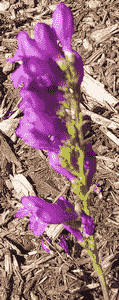 One of the most familiar and beloved wildflowers in the Rocky Mountains is the so-called “one-sided penstemon”. True to its name, the plant has its flowers all on one side of the stem.
One of the most familiar and beloved wildflowers in the Rocky Mountains is the so-called “one-sided penstemon”. True to its name, the plant has its flowers all on one side of the stem.
You can read the Wikipedia article about this plant.
Recently it crossed my mind that I had no idea why the plant goes to the trouble of keeping all of its flowers on one side of the step. So I surfed around a bit on the Internet. I figured that surely this must be a question that has occurred to others! Surely there must be web sites at which this question has been raised, thoroughly discussed, and answered fully.
But no. So far as I can tell, nobody has ever thought this to be a question worth raising. So far as I can tell, the question has never been the topic of discussion. I am not aware of anyone having answered this question.
So I will consult the hive mind of my loyal readers. Do you, kind reader, know why the one-sided penstemon goes to the trouble of being one-sided? If so, will you share the answer? Please post a comment below.

Look up inflorescence. There are lots of different arrangements of flowers.
I realize this is cheating, but ChatGPT says: The type of inflorescence a plant possesses influences pollination strategies, as well as seed and fruit production. Different inflorescence arrangements may attract specific pollinators, such as bees, butterflies, birds, or wind, depending on the flower’s shape, color, and scent. Understanding inflorescence types is essential for botanists, horticulturists, and gardeners to identify plant species and study their reproductive biology.
On a sidenote, I found an interesting detail:
“In actuality, the individual flower stems (the “pedicels”) are growing on both sides of the main plant stem, but the pedicels on one side (the right side in the photograph) bend around the stem.”
https://www.swcoloradowildflowers.com/Blue%20Purple%20Enlarged%20Photo%20Pages/penstemon%20strictus.htm
From Google’s AI BARD tool:
“The One-Sided Penstemon: Why Its Flowers Grow on One Side
The one-sided penstemon (Penstemon unilateralis) is a beautiful wildflower that is native to the western United States. It is known for its long, tubular flowers that are typically purple or pink. One of the most distinctive features of this plant is that its flowers grow all on one side of the stem.
There are a few reasons why the one-sided penstemon has its flowers on one side. One reason is that it helps the plant to attract pollinators. When the flowers are all on one side, it is easier for bees and butterflies to find them. This is because the pollinators can follow the scent of the flowers to the side of the stem where they are located.
Another reason why the one-sided penstemon has its flowers on one side is that it helps to protect the flowers from the wind. When the flowers are all on one side, the wind is less likely to knock them off the stem. This is important because the flowers of the one-sided penstemon are very delicate and can easily be damaged by the wind.
Finally, the one-sided penstemon has its flowers on one side because it helps to maximize the amount of sunlight that the flowers receive. When the flowers are all on one side, they are all facing the same direction. This means that they all receive the same amount of sunlight, which helps them to grow and bloom more effectively.
The one-sided penstemon is a beautiful and unique wildflower that is well-adapted to its environment. The fact that its flowers grow on one side is just one of the many things that makes this plant so special.
Here are some additional facts about the one-sided penstemon:
It is a perennial plant, which means that it lives for more than one year.
It can grow up to 3 feet tall.
The flowers bloom in the summer and fall.
The flowers are a source of nectar for bees and butterflies.
The plant is found in dry, open habitats, such as meadows, prairies, and rocky slopes.
If you are looking for a beautiful and easy-to-grow wildflower, the one-sided penstemon is a great choice. It is a hardy plant that is not too fussy about its growing conditions. With a little bit of care, you can enjoy this wildflower in your garden for many years to come.”
Note: the gene or gene sequence for the Penstemon unilateralis’ one-sided characteristic (e.g., genotype) may be, if not already, identified. BARD won’t do that, I guess…